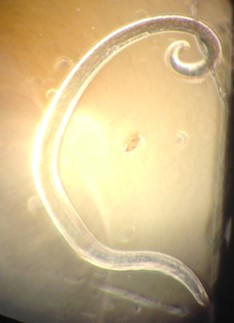In EVE 112 lab, we had the opportunity to observe nematodes, but when I asked where I could find them, the professor said “almost anywhere.” And, after searching for a short time in a sample of moss taken from the roof of a garage, we found a small, white nematode (Fig.1)!

(Fig.1) An unknown species of nematode found from moss sampled from the roof of a garage. Image Credit: Hanna Casares
Later on, a different species of nematode (Acrobeloides sp.) from a desert environment was brought into lab (Fig. 2). These nematodes are thought to benefit plants by eating harmful bacteria and in return, plants alter soil environments to favor nematode growth (Pechenik, 2010).
Nematodes, or roundworms, belong to their own phylum (Nematoda), and are tubular, appendageless, unsegmented animals with tapered ends and a distinctly circular cross section- hence the name roundworms. Nematodes are small in size: about 1-2 mm long. Their body is covered in a non-cellular, multilayered cuticle made of collagen. They lack specialized organs for gas exchange, so this thick cuticle layer is permeable to gas and water allowing gas exchange to occur directly through the body wall. The cuticle is shed and remade 4 times in their life and its structure and chemical makeup can be used to distinguish among different species. In some species, the body surface is light sensitive, other species contain ocelli, and others may contain chemosensory pits. To feed, nematodes have an anterior mouth and use a muscular pharynx to add lubricant and digestive enzymes to its food. The nematode digestive tract is linear and opens to an anus near the posterior end of the organism. Their mode of locomotion is by forming sinusoidal waves and pushing off a substrate (Pechenik, 2010).
The vast abundance of nematodes throughout the world may make them the most abundant multicellular animals alive. There are currently about 16,000 described species, but almost 1 million species are estimated to exist (Pechenik, 2010). Although nematodes are nondescript in appearance, they have adapted to almost all environments. Members of this phylum can be found basically anywhere in the world in environments ranging from polar to tropical regions. Nematodes can be found in environments too harsh for the survival of other organisms, such as deserts, hot springs, high elevations, at considerable ocean depths, and even within other organisms.
Although most species are free living, nematodes have gained notoriety for some of the diseases their parasitism causes. One such disease is elephantitis, which results in the thickening of skin and swelling of body parts (Pechenik, 2010). Just about every group of animals and many plants can be a host to nematode parasites. Some species have a complex life cycle, including many different hosts, while some only have one host in their lifetime. The largest known parasitic nematode was found in the placenta of a sperm whale and measured to be 9m (Pechenik, 2010)!
The study of nematodes can have many benefits to society. For example, in agriculture nematodes are valuable as an organic insecticide because they parasitize herbivorous insects and can also alter soil environments for plants by eating bacteria. Also, the widely known nematode, Caenorhabditis elegans C. elegans, is a helpful model organism in studies about aging, inheritance, and gene expression (Pechenik, 2010).
The nematodes basic worm-like form has helped them to exist in almost every type of habitat. And, as we discover more species, we continue to reveal their diverse ecological importance.
References:
Pechenik, J. (2010). Biology of the Invertebrates (6th ed.). McGraw-Hill.
